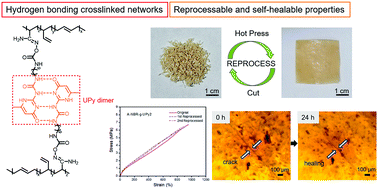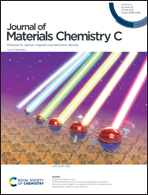Towards a tough reprocessable and self-healable acrylonitrile-butadiene rubber based on strong hydrogen bonding interactions†
Abstract
Irreversible crosslinking of covalently cross-linked rubber makes it possible to achieve outstanding mechanical properties as well as chemical resistance but makes its reprocessing impossible, which causes great waste of resources and environmental pollution. Recently, introducing reversible strong hydrogen bonding has become an emerging strategy to combine the toughening with the reprocessing potential of elastomers. Herein, we develop a tough reprocessable and self-healable acrylonitrile-butadiene rubber (NBR) by grafting 2-ureido-4[1H]-pyrimidinone (UPy) groups as physical crosslinking units onto the backbone of amidoxime NBR. The results show that the introduction of strong hydrogen bonding interactions significantly increases both the toughness and the tensile strength of the elastomer as well as the oil resistance. The tensile strength and fracture toughness of the resulting rubber reach up to 8.57 MPa and 39.12 MJ m−3, respectively, when the mass fraction of UPy-NCO is about 2.25 wt%, which are much higher than those of traditional sulphur-vulcanized NBR. The dynamic physical cross-linking networks formed by hydrogen bonds can still be continuously regenerated after being broken, which plays a helpful role in dispersing the stress concentration while ensuring the resilience as well as reprocessing capability of our resultant rubber.



 Please wait while we load your content...
Please wait while we load your content...